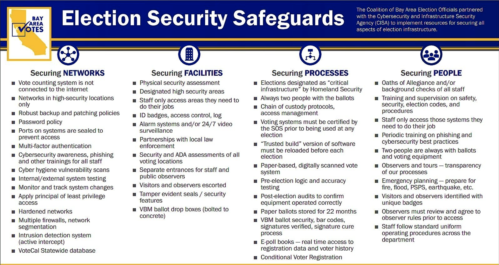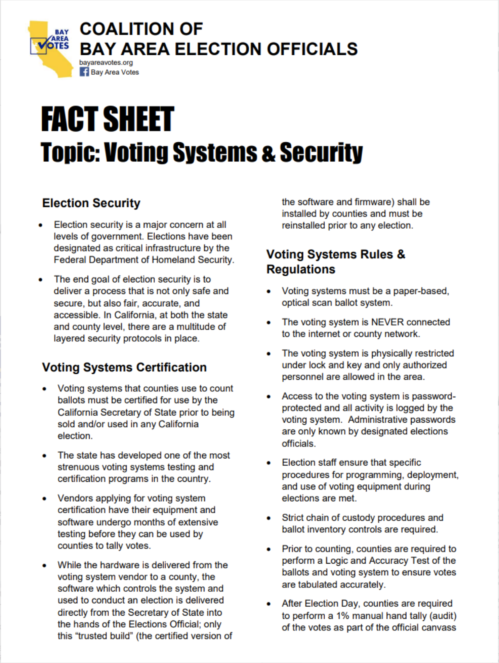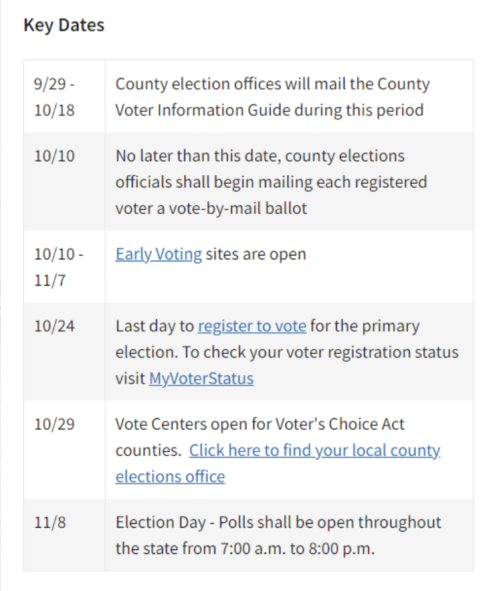August 11, 2022
How 11 California counties work together to share election information
Download the Resources:
Americans get election information from many sources. Some information is true, some is false, some is unclear, and some is downright dishonest. Election officials work hard to ensure their voices are heard amid the noise. Given the opportunity, most Americans gravitate toward the transparent and professional information provided by election officials.

The Problem
Despite election officials’ best efforts, significant obstacles hinder their ability to spread trusted election information. First, several duties compete for their time and attention. In addition to running elections, they must prioritize fighting off cyber attacks, ensuring a safe environment for staff and voters, managing their offices, and complying with many rules and regulations. Second, it is difficult for election officials to reach broad audiences. America has thousands of election officials, each sharing information with facts and themes specific to their jurisdiction, making it difficult for the media to promote their messages.
Further, it is inefficient when election officials duplicate each other’s efforts. For example, before a previous election, several Bay Area election officials each bought half-page advertisements in the Sunday edition of a widely distributed newspaper. These advertisements all promoted similar election information. As a result, each jurisdiction that bought an advertisement in that paper duplicated the considerable efforts and costs of their neighbors. Further, posting similar advertisements with different messages and details can inadvertently confuse the public.
The Solution
What if instead of operating in silos, these county officials had pooled their creativity and funds to purchase one larger, more prominently displayed advertisement over several daily editions? Further, what if election officials with shared goals regularly collaborated to cut costs and promote efficiency?
In California’s Greater Bay Area, election officials had an idea. Within their shared media market, they could pool their resources to launch a powerful campaign promoting accurate, current, and trusted election information. From that idea formed the Coalition of Bay Area Election Officials (the Coalition).
The Coalition comprises eleven Bay Area counties:
-
Alameda
-
Contra Costa
-
Marin
-
Monterey
-
Napa
-
San Benito
-
San Mateo
-
Santa Clara
-
Santa Cruz
-
Solano
-
Sonoma
These counties work together to issue press releases, fact sheets, TV interviews, social media posts, and voter education videos. They have achieved cohesive messaging and an overall reduction in costs, as well as finding allies in a lonely and challenging media ecosystem.
Obvious benefits are achieved by the lower resourced counties in the Coalition, but significant benefits of collaboration are achieved by the larger counties who are providing more time, leadership and resources. Specifically, all members are achieving a regional voice that helps enhance election officials’ credibility with a broad swath of the public. For too long, election officials have been limited in their ability to stand up for their neighbors or be reinforced by them. In the words of Tommy Gong, Contra Costa’s Deputy County Clerk-Recorder, “In the Bay Area, we are all in this together.”
The Coalition started its work early in 2022, and it has already received national recognition. The Election Center presented its prestigious “Democracy Award” to Contra Costa County and the other ten counties participating in the Coalition. The Coalition’s short-term goal is to be well-received by Bay Area residents and recognized as the Bay Area’s primary source of accurate, nonpartisan election information. As the 2024 Presidential Election Cycle approaches, the Coalition hopes to “pre-bunk”, not just debunk, inaccurate information with up-to-date, fact-based information that is relevant and resonates with voters.
The Coalition’s Approach
Good ideas take vision and leadership to come alive. This is the story of how the Coalition moved from good idea to implementation.
Establishing a shared mission and purpose
Many Bay Area elections officials felt the challenges of communicating in today’s media environment. One County took the lead and proposed collaboration. Recognizing the possible benefits, they began a conversation, which started with informal virtual meetings. These meetings were structured so that election officials could speak candidly about their various challenges, reservations, and priorities. Principals from eleven out of twelve Bay Area counties joined, which provided more than enough collaborators to work toward promoting trusted information while saving resources.
The first meeting focused on establishing a shared mission and goals, ultimately settling on “Ensuring Public Trust in Elections by collaborating, communicating, and providing access to Accurate, Current, and Transparent (ACT) election information across the Bay Area.” This message appeals to all Coalition members. As member and Napa Recorder-County Clerk John Tuteur put it, “The focus has to be the integrity of elections, not the outcome of elections.”
The Coalition’s members organized around their shared media market. In the Greater Bay Area, many local TV news and radio stations cover the entire region, many community papers share news stories with others, and digital marketing for the entire region is largely facilitated by just a few cable companies.
Generating and distributing trusted election information
After organizing and agreeing on their purpose, the Coalition built a workflow for generating and distributing trusted election information. Under that workflow, members meet weekly to discuss which issues to address in the next series of content releases. A subcommittee of staff members meets to develop the media content. Once developed the press releases, fact sheets, education videos, and other content is circulated to all Coalition members for comment. Once approved, material is released simultaneously at a scheduled time by all member counties.
The Coalition has built a series of educational videos on topics stakeholders are talking about including:
- Counting the Votes: What Happens After Election Day (The Official Canvass) – All counties
- What Redistricting Means For You in the Election – All counties
Releasing content for critical election events
The Coalition schedules its content releases to coincide with critical events in the election cycle. During the June 2022 primary, the Coalition issued a press release titled “Vote by Mail Voting is Safe & Secure” immediately before California voters received mail ballots.
Building memorable branding to increase recognition
The coalition has begun to establish a memorable and trusted brand in the Bay Area.
They produce content that is both appealing and easy to read using colorful graphics and plain language. Their brand logo uses bright blues and yellows and features an image of California.
The Coalition makes its content easy to read through simple design and repetition. Each series of fact sheets and press releases follows uniform templates. Each member releases content on the fixed schedule and includes the Coalition’s website and member county web pages. This helps constituents know exactly where, when, and how to read the trusted information coming from the Coalition.
Sharing important resources
Finally, the Coalition allows for important resource-sharing among member jurisdictions. For example, Santa Clara county hosts a Coalition webpage on their Registrar of Voters website. Contra Costa’s election officials handle many Coalition media engagements, including TV interviews. The Coalition allows member jurisdictions to play to their strengths while supporting each other, as they provide accurate, current, transparent (ACT) election information to the Bay Area.
Successes
A great success of the Coalition is that the program helps smaller counties who have fewer resources to implement and maintain a public information initiative. These counties benefit from the Coalition’s content development subcommittee, which utilizes available staff and expertise to create content like videos and press releases.
Larger counties also benefit from participating in the Coalition. As smaller counties’ mature their communications programs, the entire media market sees better election communications. Large counties also benefit from message consistency across the media market, and amplification of their priority communications.
By focusing on content creation, the Coalition has succeeded in increasing the number of trusted election resources available to Bay Area voters. On its website, the Coalition provides many fact sheets, press releases, and voter education videos that voters can trust. According to Lynda Roberts, Registrar of Voters for Marin County, California, “Winning the award from the Election Center was a great success. However, for our local election efforts, I believe the greatest success is that the Coalition has created a united voice in the Bay Area.”
Advantages of Collaborating
Bolstering Voter Education
Member jurisdictions meet regularly to discuss upcoming election challenges and to bolster region-wide voter education efforts. This promotes camaraderie among local election officials. More people involved in decision-making helps avoid missteps and blunders. According to Joe Paul Gonzalez, San Benito County Clerk, “The Coalition is a great platform for issue resolution of common problems in our outreach efforts.”
Uniform Messaging
The Coalition produces frequent and simultaneously issued press releases and fact sheets that are vetted by all participating counties.
Resource Sharing
Jurisdictions voluntarily share vital resources. For example, Santa Clara county’s website hosts a web page for the Coalition. While counties do not share staff, the Coalition can make use of available staff from member counties to assist in creating content. Debi Cooper, County Clerk-Recorder for Contra Costa County notes “Sharing resources and creative ideas has helped us evolve our messaging!”
Mutual Support
Jurisdictions that are comfortable working with the media can assist other jurisdictions that are interacting with the media.
Division of Labor
The Coalition is a team, which allows member counties to play to their strengths. A county with strong media relationships can step up for television interviews, radio appearances, and other media opportunities.
Sample Resources



Costs
Money
The Coalition began without any pooled financial resources. So far, the Coalition’s work has been done through the collaboration and good will of its members. However, Coalition members have begun to explore funding mechanisms for future projects. Specifically, funding could help the Coalition purchase print or TV advertising. One possibility is that member counties would contribute funds based on the number of registered voters in each county. Many member jurisdictions do not have funding for advertising or marketing.
Time
Members must spend their time attending virtual Coalition meetings. All member jurisdictions attend weekly planning meetings, and a subset of members’ principals and staff work on the content development subcommittee. Additionally, members spend time reviewing copy and driving Coalition priorities. Eventually, coalitions like this save time by reducing duplicate work and planning project calendars.
Challenges
Building Trust
Trust among member counties is critical. Establishing trust can be difficult in an election environment where bad actors are decontextualizing and amplifying narratives that undermine local election officials’ work. The Coalition builds trust by holding virtual meetings for members, including those crucial first meetings. These meetings are not recorded, so that members can speak candidly about election issues facing their communities. Additionally, the Coalition regularly places members into smaller breakout groups to have personal, engaging conversations on election issues. According to Tommy Gong from Contra Costa County, “These sessions encouraged members to participate and share ideas.”
Content Development
All member counties meet weekly to refine the Coalition’s content release schedule and to determine what election issues to prioritize in upcoming content. The Coalition is flexible about using free and inexpensive tools to determine what content belongs in future releases. For example, early on members were issued a survey that listed many election topics. Members were asked to rank their top five, and the survey results were used to drive Coalition priorities.
As the coalition has developed, it has turned to other organizations to support their content building. For example, in the lead up to the 2022 general election they utilized services provided by The Elections Group’s Communications Resources Desk who assisted with media and communications efforts including drafting and editing materials for publication as well as strategic advice.
Differing Policies
Certain laws and policies were hurdles for the Coalition. For example, some but not all jurisdictions in the Coalition have vote centers. Because member counties do not have uniform policies on certain processes, like the establishment of vote centers, the Coalition cannot always issue uniform messaging. To remedy this, the Coalition will either create broader messaging or give counties the discretion of modifying fact sheets or press releases.
Infrastructure Needs
To implement a program like the Coalition, local jurisdictions should take advantage of any infrastructure available to them. Below are some examples.
Staff with Communications Expertise
The Coalition’s focus is voter education. It relies on member counties with staff and leadership with excellent written and verbal communication skills and connections to local media affiliates. These communications experts are leveraged and prioritized to assist other jurisdictions as needed. These experts lead on developing and producing content.
Time
Coalition members meet weekly to plan future content releases. However, there are several additional time commitments. Many leaders and staff dedicate additional time to developing, drafting, and releasing content.
Tools
Several tools are critical to the Coalition’s success. Fortunately, many of those tools are cheap or free, including:
- Virtual meeting software
- Press releases following a standardized template
- Fact sheets
- Contact sheets with a listed media contact for each member jurisdiction
- A secure .gov or .org website to host content
- Materials to produce voter education videos. These can range from high quality video and audio equipment and editing software to simply a smartphone.
The Elections Group is offering communications resources and support for election officials by election officials at low cost or free of charge. To request assistance, contact The Elections Group.
Sustainability
The Coalition is an entirely voluntary group. The Coalition’s continued success relies on strong organization and leadership.
Weekly meetings sustain the Coalition. All member counties are expected to send an attendee to each meeting. This keeps members informed and engaged. A regular content release schedule keeps members invested and on notice of important upcoming content. Because members are associated with the Coalition’s content, they have an interest in engaging with that content both before and after it is released into their communities.
Recognitions
- Contra Costa County received an Election Center 2022 Professional Practices Papers Democracy Award for its work as a member of the Coalition of Bay Area Election Officials.
- Bay Area elections officials team up to educate voters, curb misinformation By Greg Lee KTVU Published May 16, 2022
- Bay Area elections officials team up in midterm misinformation fight By Keith Menconi, KCBS Radio April 25, 20225:22 pm
- What Bay Area elections officials want you to know about ballot safety before the primary elections by: KRON4 Staff Posted: Jun 5, 2022 / 11:48 AM PDT Updated: Jun 5, 2022 / 12:12 PM PDT
Tools for a Successful Coalition
Several tools are critical to the Coalition’s success. Fortunately, many of those tools are cheap or free, including:
-
Virtual meeting software
-
Press releases following a standardized template
-
Fact sheets following a standardized tempalte
-
Contact sheets with a listed media contact for each jurisdiction
-
A secure .gov or .org website to host content
-
Materials to produce voter education videos. These can range from high quality video and audio equipment and editing software, to simply a smartphone.
The Elections Group is offering communications resources and support for election officials by election officials at low cost or free of charge. To request assistance, contact us here..



